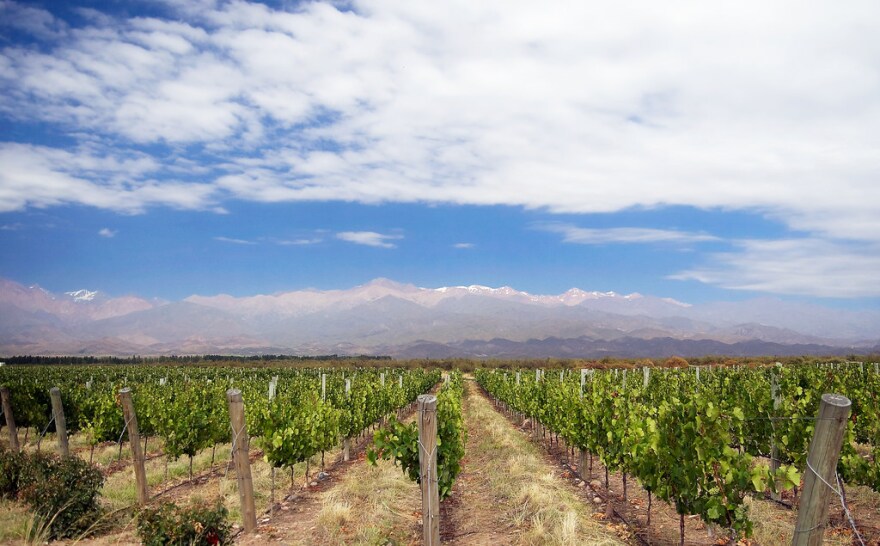Attorney Rachel Streitfeld is a Miami millennial – and, like many if not most millennials, she's a wine lover. But she’s not into Cabernet or Merlot or other traditional reds. Sitting outdoors at Bunbury downtown, Streitfeld has just opened a bottle of Argentine Malbec.
“I don’t drink Cabernet Sauvignon because it makes me think about the wine my parents would buy for Shabbat dinner,” Streitfeld says, savoring the first sips of a 2013 DiamAndes de Uco.
“Any time I have a girls night, Malbec is pretty much going to be my go-to bottle.”

Thanks to fans like Streitfeld, Malbec even has its own day. April 17 was World Malbec Day and Miami was one of 44 cities around the world where a bash was held, in Edgewater by Biscayne Bay. Among the Malbec devotees was University of Miami Latin American history professor Steve Stein, a South American wine expert.
“It’s a more fruit-forward, a more rounded and easier wine to like,” Stein told me after giving a speech on Malbec at the Edgewater fiesta. “The average wine drinker is looking for something that creates immediate pleasure. It’s damn good.”
READ MORE: Why Caribbean Rum Is the New Cognac - And Why Miami Is Its Showcase
To skeptics, this Malbec movement might sound like the kind of stampede pasión wine lovers are notorious for. But it’s real – and it represents a real shift in the wine market. In just the past decade, Malbec’s exports have soared as high as the Argentine Andes where the wine is made.
Since 2006, Argentine Malbec’s global sales have quintupled to more than $500 million. Here they’ve grown sixfold to $190 million – making Argentina now the fourth biggest wine exporter to the U.S.
If you asked somebody in the first decade of the 2000s, what Latin American wine should I drink, they'd say, why, Chilean. If you ask somebody now, they'll say Argentine. – Steve Stein
“Fastest growing varietal in the United States,” says Stein. “If you asked somebody in the first decade of the 2000s, what Latin American wine should I drink, they’d say, why, Chilean. If you ask somebody now, they’ll say Argentine.”
Chile – its Cabernets and Carménères – had always been el rey, the king, of Latin American wine. So how are Argentina and Malbec usurping the throne – especially in a Latin American city like Miami?
Start with the tale of the grape.
“Malbec arrived to Argentina almost 200 years ago from France,” Alberto Arizu, president of Wines of Argentina, said from Buenos Aires.
Arizu pointed out that before Malbec vines were brought to Argentina, the grape was just an obscure fruit used for blending with wine legends like Cabernet Sauvignon. But then Malbec was planted in the Andes – in the higher, cooler altitude of Argentina’s Mendoza valley.

“The temperature and the contact with U.V. rays at 3,000 feet above sea level made a great difference,” said Arizu. “Here the Malbec became a wine with very mature character, velvety in the mouth, more richness in the style of the wine.”
Argentina didn’t get serious about mass-producing and marketing Malbec until the economic boom of the 1990s. But Argentina’s strong currency made the wine expensive to buy abroad. Even lower end bottles topped $20. That is, until Argentina’s economy and its currency collapsed in 2001.
Suddenly Malbec was an affordable import, and the rest of the world started drinking it – and praising it.
"It's like buying a car that works," said retired South Florida realtor Kevin Ries at the Edgewater party.
GAUCHO CACHET
In the U.S. especially, Malbec has suited a preference for more full-bodied, fruit-forward wines.
But Malbec has another marketing weapon – cue tango music – which is Argentina itself.
“Icons like the gaucho, the meat, the tango,” says Leo Graziano, who heads Graziano’s, his family’s Argentine restaurant and market chain in South Florida.

At his market in Coral Gables, Graziano shows off the thousands of Malbec bottles on the shelves from now-famous wineries like Catena, Luigi Bosca, Zuccardi – and his favorite, Rutini, whose popular Encuentro is under $20. They’re his best-selling product. And he says one reason is those romantic Argentine symbols.
“The backdrop of the Andes, it’s beautiful,” says Graziano. “Every time you go it’s a post card.”
Which brings us back to Miami lawyer Rachel Streitfled – and perhaps Malbec’s biggest asset: millennials, who have fallen for the wine – and its gaucho cachet – harder than any other group, according to the Wine Market Council.
That matters because millennials – the 21-to-35-year-old cohort – drive wine sales today. They consume 42 percent of the wine sold in the U.S. And they rate Malbec as one of their favorites.
“I like trying wines from other parts of the world,” Streitfeld says. “And Malbec – I like to pretend I’m in Argentina when I’m drinking it. Dancing the tango for sure – maybe with a handsome Argentinian man.”
There are Malbec critics – who say its focus on pleasing American palates has made the wine too predictable. Which means if Malbec really wants to be el rey, it might have to learn new steps – just like a tango dancer.




